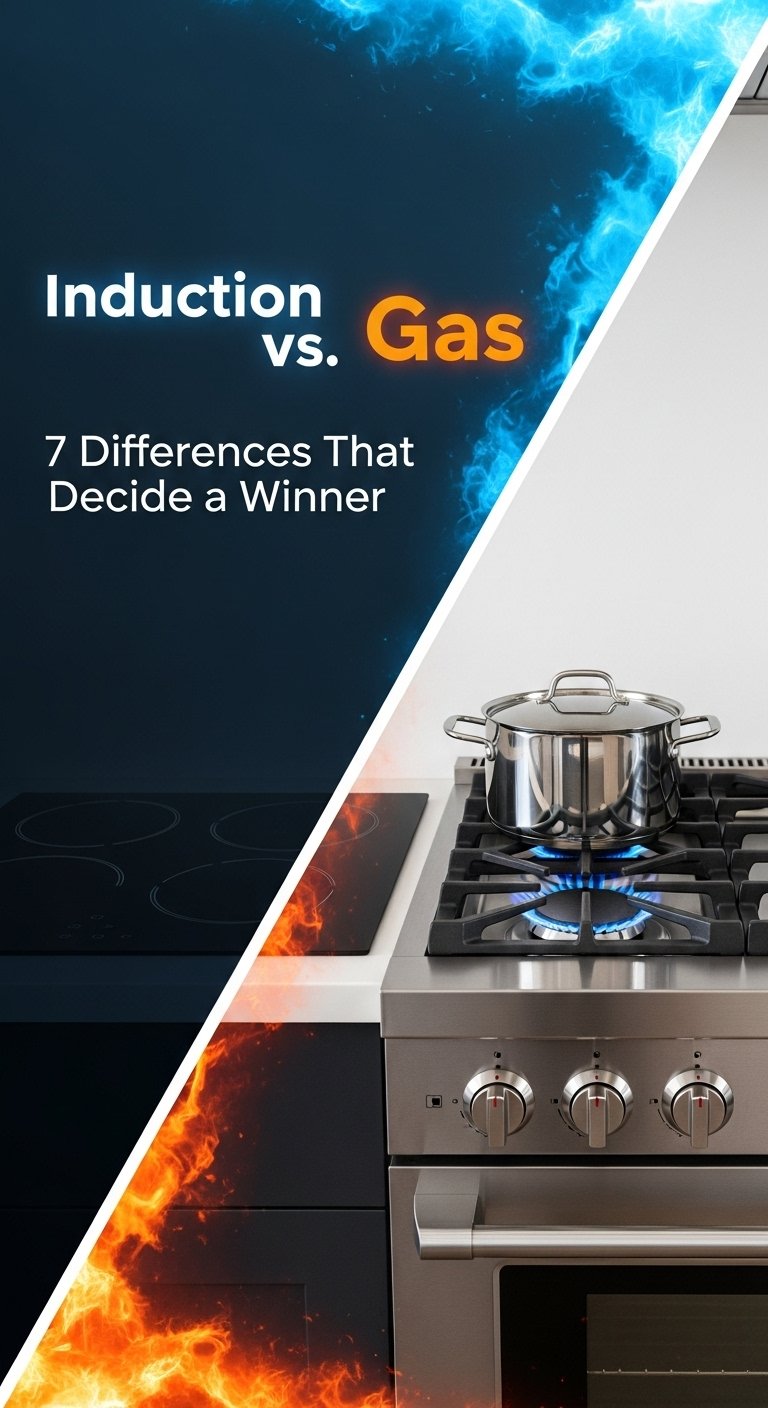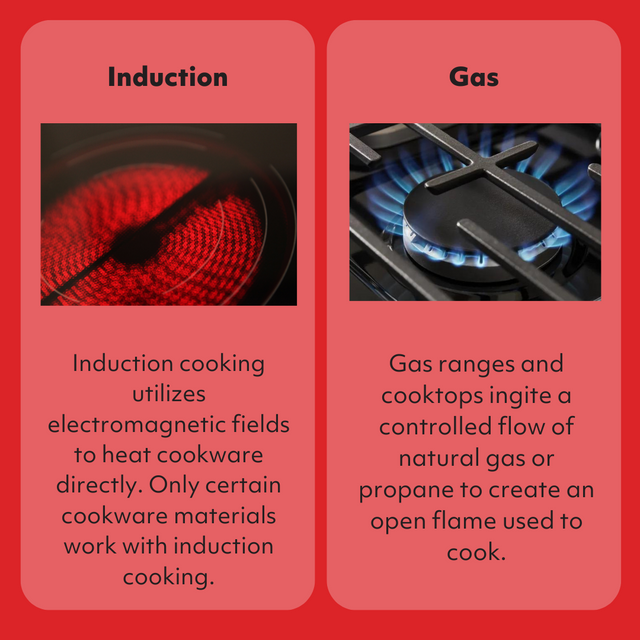As an Amazon Associate KitchenwareSets.com earns from qualifying purchases.
Induction vs. Gas: 7 Differences That Decide a Winner
Deciding between an induction cooktop and a traditional gas stove is one of the biggest choices you’ll make for your kitchen. It’s a classic battle of new technology versus old-school tradition, and the answer isn’t just about cooking style—it’s about efficiency, safety, and the health of your home. Are you prioritizing speed and efficiency, or the familiar feel of a flame? Let’s break down the data to find your answer.
For most modern kitchens, induction cooktops are better than gas due to superior energy efficiency, faster cooking speeds, enhanced safety, and healthier indoor air quality. This conclusion is based on extensive analysis of performance data and findings from trusted sources like ENERGY STAR® and Consumer Reports. While gas offers a lower upfront cost and a familiar flame, induction’s long-term benefits in performance and health make it the superior choice for a majority of households in 2025.
To see the differences at a glance, here’s a quick comparison:
| Feature | Induction Cooktop | Gas Cooktop |
|---|---|---|
| Energy Efficiency | ~85% (Very High) | ~32% (Low) |
| Cooking Speed | Fastest | Slower than Induction |
| Safety | Very Safe (No Flame, Cool Surface) | Less Safe (Open Flame, Hot Grates) |
| Indoor Air Quality | Excellent (No Emissions) | Poor (Releases Pollutants) |
| Cleaning | Very Easy (Smooth Surface) | Difficult (Grates & Burners) |
| Upfront Cost | Higher | Lower |
| Cookware Needs | Magnetic (Cast Iron, etc.) | Any Cookware |

Key Facts
- Unmatched Efficiency: Induction cooktops are dramatically more efficient, converting about 85% of their energy directly into heat for your food. Gas cooktops, as highlighted by data from the U.S. Department of Energy, waste most of their energy, achieving only about 32% efficiency.
- Proven Speed Advantage: In performance tests, induction consistently proves to be faster, boiling water 20% to 40% more quickly than even high-powered gas ranges.
- Significant Health Impact: A major study has linked gas stove emissions to 12.7% of all childhood asthma cases in the United States, a risk that is completely eliminated with emission-free induction cooking.
- Built-in Safety: Because induction heats the pan directly, the cooktop surface remains cool to the touch, drastically reducing the risk of burns compared to the open flames and hot grates of a gas stove.
- Cookware Requirement: The primary consideration for switching to induction is the need for magnetic cookware. Common materials like cast iron and most stainless steel pans work perfectly, but aluminum, copper, and glass pans do not.
Cooking Performance: Speed, Power & Precision Control
Induction cooktops offer superior performance, boiling water up to 40% faster and providing instant, precise temperature adjustments that gas struggles to match, especially at very low heat. This isn’t just a minor improvement; it fundamentally changes the cooking experience. When evaluating are induction cooktops better than gas for pure performance, induction takes a commanding lead.

Here’s why:
- Unbelievable Speed: Thanks to its electromagnetic heating method, an induction element delivers energy directly to the pan. This means less wasted heat and much faster results. Citing performance data, induction can boil a large pot of water 20-40% faster than its gas or conventional electric counterparts.
- Instantaneous Response: Just like gas, induction responds instantly when you adjust the power. But unlike gas, that response is incredibly precise across the entire temperature range.
- Unmatched Low-Heat Control: This is where induction truly shines. Gas flames can be difficult to control at very low settings and can easily flicker out. Induction can hold an exact, steady low temperature without any issue.
As noted in reviews from The New York Times, this precision is why many home cooks find that induction can perfectly melt chocolate directly in the pan without a double boiler, a task that is notoriously difficult on a gas stove where heat is uneven and hard to control at low levels.
Pro Tip: Think about the last time you tried to simmer a delicate sauce. Induction’s ability to hold a precise low temperature without the flame dying out is a game-changer for home cooks.
Energy Efficiency & Lifetime Cost: Which Is Cheaper to Run?
Induction cooktops are up to three times more energy-efficient than gas (85% vs 32%), leading to significant long-term savings on energy bills that can offset their higher initial purchase price. When analyzing the induction vs gas running cost, the numbers clearly favor induction.
The core of this advantage lies in how each cooktop transfers energy. A gas stove’s open flame heats the pan, but it also heats the grates and the surrounding air, wasting nearly 70% of its energy. An induction cooktop, by contrast, is incredibly targeted. According to figures from ENERGY STAR® and the U.S. Department of Energy, induction is ~85% efficient, while gas is only ~32% efficient.
Quick Fact: While a gas stove is about 32% efficient, an induction cooktop boasts ~85% efficiency. That means 85 cents of every dollar spent on electricity goes directly into your food.
When considering the total gas vs induction stove monthly cost and lifetime value, you need to look at the complete financial picture:
* Upfront Purchase Price: Gas cooktops are generally cheaper to buy. However, the price gap for induction models has been shrinking significantly.
* Installation Costs (Electrical Upgrade): If you are switching from gas, you may need to hire an electrician to install a 240-volt outlet, which is a necessary added cost.
* Long-Term Energy Savings: This is induction’s biggest financial win. The superior energy efficiency translates directly to lower monthly utility bills, allowing you to recoup the higher initial investment over the appliance’s lifespan.

Health & Safety: The Critical Difference in Your Home
Induction cooktops are significantly safer, with no open flame and a cool surface. Critically, they don’t release harmful indoor pollutants like nitrogen dioxide and benzene, which are linked to respiratory issues like asthma. This is perhaps the most compelling reason why are induction cooktops better than gas for families and health-conscious individuals.
The safety benefits are immediate and obvious. With no open flame, there’s no risk of igniting a nearby kitchen towel or creating a fire hazard. The glass surface itself doesn’t get hot, only the pan does, so the risk of accidental burns is dramatically lower—a huge plus for households with children.
But the bigger story is about the air you breathe. Gas stoves are a major source of indoor air pollution. Studies have shown they release a cocktail of harmful chemicals, including:
* Nitrogen Dioxide (NO₂)
* Carbon Monoxide (CO)
* Formaldehyde
* Benzene (a known carcinogen)
These pollutants are linked to serious health problems, especially respiratory conditions.
According to a peer-reviewed study, the link is startlingly clear: 12.7% of all current childhood asthma cases in the U.S. can be attributed to gas stove use. This finding adds significant weight to the argument for the health benefits of induction.
Relatable Analogy: Choosing induction is like removing a source of secondhand smoke from your kitchen. It produces virtually no indoor air pollutants for a healthier home environment.
Cleaning & Maintenance: The Clear Winner for Easy Cleanup
Induction cooktops are far easier to clean thanks to their flat, smooth glass surface where spills don’t burn on. Gas cooktops require laborious scrubbing of grates and burners. For anyone who values their time and dislikes chores, the answer to whether are induction cooktops better than gas is a resounding yes when it comes to cleanup.
The difference is night and day. Because the induction surface itself stays relatively cool, splatters from a sauce or a pot boiling over don’t bake onto the glass. A simple wipe with a damp cloth is usually all it takes to make it look brand new.
Anyone who has scrubbed burnt-on food from a heavy, awkward gas burner grate will appreciate the simplicity of induction. The complex structure of gas stoves, with their grates, burner caps, and crevices, creates a cleaning nightmare.
Here’s a direct comparison of the cleaning process:
| Cleaning Task | Induction Cooktop | Gas Cooktop |
|---|---|---|
| Daily Wipedown | Quick wipe with a cloth (seconds) | Wipe around heavy grates and burners |
| Spill Cleanup | Wipe away immediately; nothing burns on | Spills burn on instantly, requiring scraping |
| Deep Clean | Polish the flat glass surface | Remove grates, scrub grates, clean burners |
How much time do you spend scrubbing your cooktop each week? Imagine reducing that to a simple wipe with a damp cloth. That’s the practical, everyday benefit of choosing induction.
Induction Drawbacks & Considerations: What You Need to Know
The main disadvantages of induction are the need for magnetic cookware, a higher initial cost, potential electrical installation, and that it won’t work during a power outage. To provide a fair comparison, it’s crucial to transparently address the valid concerns about why induction cooking is bad for some users. These are factors you must consider before making a decision.
As noted by sources like Consumer Reports and in discussions on forums like Reddit, here are the primary drawbacks:
- Special Cookware is Required: Induction technology relies on electromagnetism, so your pots and pans must be magnetic. Cookware made from cast iron and magnetic stainless steel works perfectly. However, pans made of aluminum, copper, or glass will not work without an adapter disk.
- Higher Upfront Cost: While prices are falling, induction cooktops and ranges still typically cost more to purchase than their gas counterparts.
- Potential Installation Needs: If your kitchen is only wired for a standard 120-volt outlet and set up for a gas line, you will need to hire an electrician to install a dedicated 240-volt circuit, adding to the overall cost.
- A Slight Humming Noise: Some users report a faint buzzing or humming sound, especially on high power settings. This is caused by the high-frequency vibrations of the electromagnetic field and is usually not disruptive.
- Useless During a Power Outage: An induction cooktop is completely reliant on electricity. Unlike a gas stove that can often be lit with a match during a blackout, an induction cooktop will not function.
Pro Tip: Test your current cookware with a simple magnet. If it sticks firmly to the bottom, it’s induction-ready!
To get the most out of your new cooktop, having the right magnetic pots and pans is essential. Here are some of the bestselling induction-ready cookware sets available.
FAQs About are induction cooktops better than gas
Do professional chefs prefer gas or induction?
While many chefs traditionally used gas for its visual flame, a growing number now prefer induction for its unmatched power, speed, and precise temperature control, especially in modern professional kitchens. The “lizard-brain appeal” of a live flame, as The New York Times puts it, is strong and familiar. However, for pure performance—getting a large pot of water to boil in seconds or holding a delicate sauce at the perfect temperature—induction is technically superior, leading many high-end restaurants and professional chefs to make the switch.
What are the main disadvantages of an induction stove?
The primary disadvantages are the requirement for magnetic cookware (like cast iron), a higher initial cost than gas, the need for a specific electrical outlet, and its inability to function during a power outage. Additionally, some users may notice a slight humming sound during operation, and the flat glass surface, while easy to clean, can be scratched by rough-bottomed pans if not used carefully. These are the key induction cons highlighted by sources like Consumer Reports.
Do I really need to buy all new pots and pans for induction?
Not necessarily. Many common types of cookware, like cast iron and most stainless steel, are already induction-compatible. You can test yours by seeing if a magnet sticks firmly to the bottom. If it sticks, you’re good to go. If it doesn’t, that specific pan won’t work.
* Compatible: Cast Iron, Enameled Cast Iron, most Stainless Steel.
* Incompatible: Aluminum, Copper, Glass, fully ceramic pans.
So, before you budget for all-new cookware, perform the simple magnet test on what you already own.
Is an induction cooktop cheaper to run than gas?
Yes, induction cooktops are significantly cheaper to run. They are about three times more energy-efficient than gas, meaning less energy is wasted and your monthly utility bills will be lower. Based on Department of Energy data, induction cooktops have an energy efficiency of around 85%, compared to just 32% for gas. This means a much larger portion of the money you spend on energy goes directly into cooking your food, reducing the induction vs gas running cost over time.
Final Verdict: Is an Induction Cooktop Better Than Gas for You?
After comparing performance, cost, safety, and convenience, the data clearly shows that for most people, induction is the superior technology. It cooks faster, gives you more precise control, is far more energy-efficient, and creates a safer, healthier home. However, the “better” choice ultimately depends on your personal priorities, kitchen setup, and cooking style.
This final breakdown should help you make a clear decision.
Choose Induction If You Value…
* Speed & Performance: You want water to boil faster and temperatures to adjust instantly.
* Safety & Health: You have children, are concerned about burns, or want to eliminate indoor air pollutants from your home.
* Energy Efficiency: You want to lower your monthly utility bills and reduce your carbon footprint.
* Easy Cleanup: You’d rather wipe down a smooth surface in seconds than scrub heavy grates.
Stick with Gas If You Prefer…
* Lower Upfront Costs: Your budget for the initial purchase and installation is the primary deciding factor.
* Cookware Freedom: You love your current collection of non-magnetic pans (like copper or aluminum) and don’t want to replace them.
* Cooking During Power Outages: You live in an area with frequent power outages and need a cooktop that can still function.
* The Traditional Flame: You simply love the visual feedback and familiar experience of cooking over an open flame.
Now that you have the data, which cooktop aligns with your kitchen priorities? The choice between the familiar glow of gas and the futuristic power of induction is yours.
Last update on 2025-12-31 at 00:26 / Affiliate links / Images from Amazon Product Advertising API
